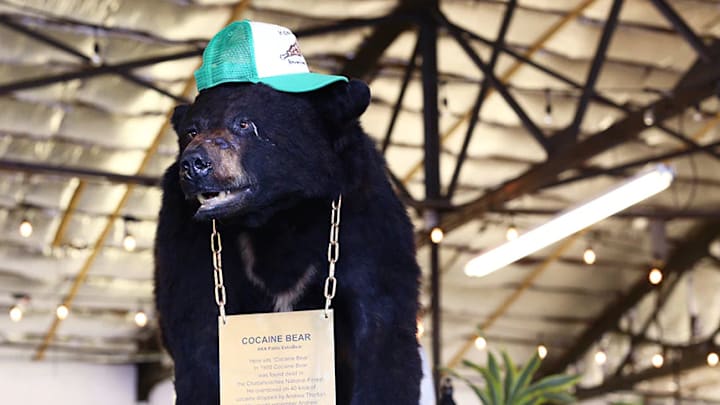Nearly 40 years after a black bear ingested a fatal amount of cocaine dumped in Georgia’s Chattahoochee National Forest, his memory lives on. His story is the inspiration behind Cocaine Bear, a new movie directed by Elizabeth Banks that hits theaters on Friday, February 24. But before he was revived for the silver screen, “Pablo Escobear” was immortalized through taxidermy. His stuffed remains are on display at the Kentucky for Kentucky Fun Mall, and the story of how they got there is nearly as wild as his infamous death.
Though his drug-fueled rampage is a Hollywood fabrication, a bear really did consume millions of dollars’ worth of cocaine in 1985. Forty packages of the contraband ended up in the Georgia woods when Andrew Carter Thornton II, a Kentucky drug kingpin, dumped it from his plane when the engine started malfunctioning. He jumped from the aircraft with 75 pounds of cocaine strapped to his body and died when his parachute didn’t open properly. The bear that stumbled upon the illegal substance became the story’s second fatality.
Authorities later found the animal’s corpse in the Chattahoochee National Forest surrounded by 40 opened packages of cocaine. The necropsy (or animal autopsy) revealed that his stomach was packed to capacity with the drug. The overdose had triggered cerebral hemorrhaging, a stroke, respiratory failure, renal failure, heart failure, and hyperthermia, but the bear’s body appeared to be in decent shape from the outside. The medical examiner decided it would be a shame to let it go to waste, so he had it stuffed and donated it to the Chattahoochee River National Recreation Area.
That would have been a fitting end to the bizarre saga, but Cocaine Bear’s story wasn’t over. After being displayed in the park’s visitor center, he was moved into storage in the early 1990s out of caution due to a nearby wildfire. The facility was robbed less than a month later, and the bear ended up in the hands of country star Waylon Jennings.

Jennings claims he had no idea the item was stolen when he purchased it from a pawn shop. By the time he heard how it ended up there, it was too late: He had already gifted it as an inside joke to his friend and Vegas hustler Ron Thompson, whom he knew had been friends with Thornton before his doomed drug run.
So after its glamorous journey to a Nevada mansion, how did the taxidermied bear end up in a Lexington, Kentucky, mall? The mall had been keeping tabs on the bear’s whereabouts, and after Ron Thompson passed away in 2009 they learned it had been purchased at an auction by a Chinese immigrant in Reno named Zhu T’ang. T’ang died just a few years later, and when the mall reached out to his widow about acquiring the bear, she was happy to get rid of it. Cocaine Bear has called the mall home since 2015.
“When he first arrived, regionally, some folks knew the story, so it was a fun [anecdote] for people to point out to visiting friends,” Griffin VanMeter, co-owner of the Kentucky for Kentucky Fun Mall, tells Mental Floss. In recent years, the stuffed bear has become a destination in its own right. “Because of the sustained media attention even before the movie, Cocaine Bear has been a sought-after tourism attraction. Some super fans have even started to leave trinkets and offerings at the base of the bear, like a knitted kilo of cocaine!”
After seeing Cocaine Bear in theaters, you can visit the real-life cocaine bear on display at the Lexington Mall—just be sure that any gifts you bring for him are above-board.
